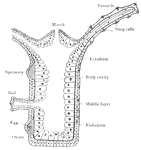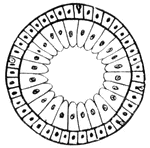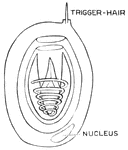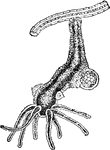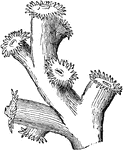The Corals and Sea Anemone ClipArt gallery provides 241 images of corals and sea anemone in the phylum cnidaria. They attach themselves to the bottom using an adhesive 'foot', called a basal disc.
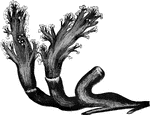
Alcyonium elegans
"In the genus Alcyonium, the polypidom is of a spongy nature, and contains a multitude of minute calcareous…

Epiderm Cels
"Epidermo-muscular cells of Hydra m, muscular-fiber processes." — Encyclopedia Britannica, 1893

Eupsamma
"Eupsamma. A genus of perforate stone-corals, as E. brongniartiana (shown here), of the family Eupsammidae."…
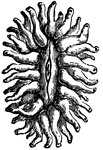
Flabellum Pavonium (Lesson)
"In the subfamily of the Zoanthidae, the polyps occur in clusters, and are multiplied by buds, rising…
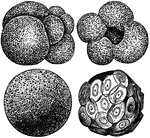
Foraminifera
These animalcule are so small that 1,000,000 are equal in bulk to only one cubic inch. They appear to…

Colony of Heliopora coerulea
"Portion of the surface of a colony of Heliopora coerulea magnified, showing two calices and the surrounding…

Heliopora Corerulea
"A, Portion of the surface of a colony of Heliopora coerulea magnified, showing two calices and the…

Hydra
"Nettling cells of Hydra. A, unexploded; B, exploded; b, barbs; c, the nettling cell in which the nettling…
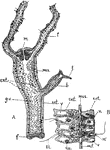
Hydra
"A, Longitudinal section through the body of Hydra (diagrammatic). B, small portion of the wall more…

The Digestive Apparatus of a Hydra or Freshwater Polyp
In Radiata the digestive cavity is a pouch with a single opening, into which the food is passed and…
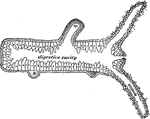
Section of a hydra
"Longitudinal section of a Hydra; b, bud which will form a young one; ba, base by…
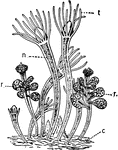
Hydractina Echinata
"Hydractina Echinata. c, the canosarc, forming an incrustation over the object on which it lives; n,…

Hydractinia
"Diagram of a colony of Hydractinia, showing four forms of persons. a, hydriform person; b, modified…

Hydractinia
"Colony of Hydractinia on back of a Buccinum shell tenanted by a hermit-crab." -Thomson, 1916
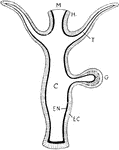
Hydrazoan Polyp
"Diagram of a typical Hydrozoan polyp. EC., Ectoderm; EN., endoderm; C., the cavity of the gut (coelenteron);…

Hydroid
"Diagram of a gymnoblastic Hydroid. a., Stem; b., root; c., gut cavity; d., endoderm (dark); e., ectoderm;…

Hydroid Blastula
"A, blastula in which the entoderm (ent.) is produced by proliferation from ectoderm (ect.)." -Galloway,…

Hydroid Colony
"A. A small piece of hydroid colony. p., Perisarc; m., medusoid bud; h., hydranth or polyp head." -Thomson,…
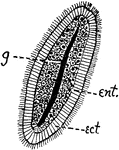
Hydroid Planula
"B, ciliated planula formed by the continuance of this process. A split in the entoderm furnishes the…

Mature Hydroid Planula
"C, more mature condition, in which the planula has become fixed: f, foot or attached end; o, oral or…
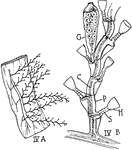
Campanularian Hydroid
"Hydroids. IV A. Campanularian. IV B. A fragment enlarged, showing stalked hydrothecae (H.), a gonotheca…

Campanularian Hydroid
"Campanularian Hydroid. H., Hydrotheca or polyp-cup; HY., hydranth, or polyp-head; G., gonotheca, enclosing…
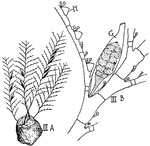
Plumularia Hydroid
"Hydroids. III A. Plumularia. III B. A fragment enlarged, showing hydrothecae (H.) on one side of each…

Sertularia Hydroid
"Hydroids. II A. Piece of Sertularia. II B. A fragment enlarged, showing sessile hydrothecae (H.) on…

Hydromedusa
"Diagram showing possible modifications of persons of a gymnoblastic Hydromedusa. a, hydrocaulus (stem);…

Hydromedusa
"Diagram showing possible modifications of the persons of a Calyptoblastic Hydromedusa. a, hydrocaulus…

Idyia Roseola
"Idyia roseola. Seen from the broad side, half natural size. a, anal opening; b, lateral tube; c, circular…

Isis Hippuris
"A species of Isis has numerous slender branches, furnished with cylindrical knows at intervals,…
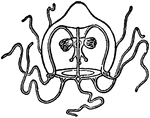
Lizzia
"Medusiform person (Lizzia), one of the Anthomedusae, detached from a hydroid colony of the family Endendridae.…
Loose Winged Virgularia (Virgularia Mirabilis)
"These winged species of polypidom are somewhat scythe-shaped, well developed, and furnished with a…

Branch of Loose Winged Virgularia
"These winged species of polypidom are somewhat scythe-shaped, well developed, and furnished with a…

Madrepora Plantaginea (Lamarck)
"The Plantain Madrepore is an interesting species, the polyps presenting themselves in tufts, with slender…

Medusa
"Diagram of Medusa, illustrating radial symmetry. A, viewed from the oral end of the principal axis;…

Medusae
"Portions of sections through the disc of medusae. The upper one of Lizzia, the lower of Aurelia. el,…
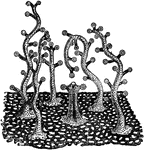
Millepora
"Enlarged view of the surface of a living Millepora, showing five dactylozooids surrounding a central…
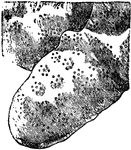
Millepora Nodosa
"Portion of the calcareous corallum of Millepora nodosa, showing the cyclical arrangement of the pores…

Muscular Cells
"Muscular cells of medusae (Lizzia). The uppermost is a purely muscular cell from the sub-umbrella;…

Nematocyst
"Nematocyst of Hydra, showing cell-substance and nucleus, cyat, trigger hair, and everted thread." —…

Ocellus
"Ocellus of a medusa (Lizzia Koellikeri). oc, pigmented ectodermal cells; l, lens." — Encyclopedia…

Oculina Virginea (Lamarck)
Oculina ranges from Cape Hatteras, North Carolina through the Gulf of Mexico and Caribbean, though the…

Pennatula Phosphorea
"A. Colony of Pennatula phosphorea from the metarachidial aspect. p, The peduncle. B, Section of the…

Colony of Pennatula phosphorea
"Colony of Pennatula phosphorea from the metarachidial aspect. p, The peduncle. B, Section…

Plumatella
"Diagram of an Ectoproctous Polyzoon (Plumatella). L., Lophophore; PH., pharynx; A., anus; S., stomach;…
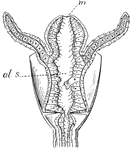
Polyp
Obelia, a simple polyp, vertical section, highly magnified, m = mouth opening, as.s = alimentary sac

Polyp
"A hydroid colony of six polyps; f, feeding polyp; r, reproductive polyp; m, a medusa." —Davison,…


